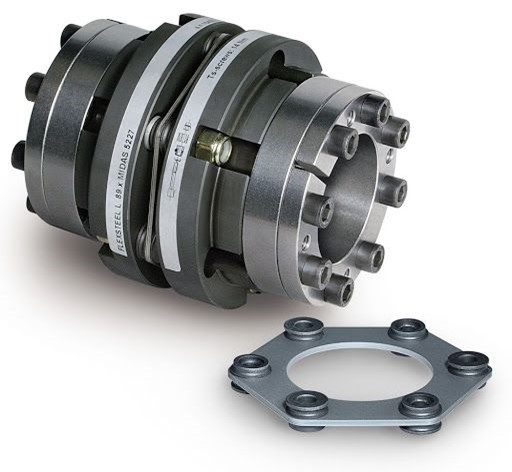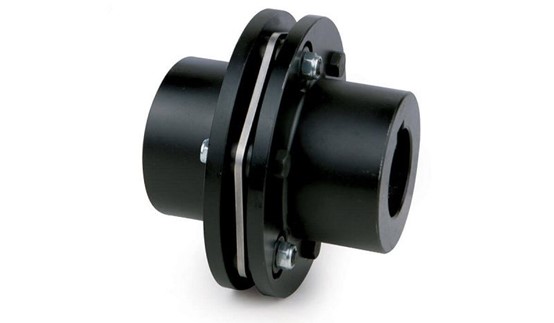Disc Coupling Working Principle
Most of us probably never notice the spinning cylinder mounted between the pump and motor used in dozens of general industrial applications and specialized applications. A disc coupling is used to efficiently transmits torque. This article will give a complete answer to the question, “what is disc coupling?”.
What is Disc Coupling?
As you may know, the coupling is a mechanical element part that connects two shafts to accurately transmit the power from the drive side to the driven side while absorbing the mounting error. So, What is Disc Coupling? A disk coupling is a flexible shaft coupling that transmits torque from a driving to a driven bolt tangentially on a common bolt circle. This torque is transmitted between the bolts through a series of thin, stainless steel discs assembled in a pack. The flexibility of these couplings comes from the deformation of the material between the bolts. Disk couplings are suited for high-performance motion control applications and can typically handle speeds of up to 10,000 rpm.
Disc Coupling Working Principle
The disc coupling’s principle of operation has the torque transmitted through flexing disc elements. It operates through tension and compression of chorded segments on a common bolt circle bolted alternately between the drive and driven side. These couplings are typically comprised of two hubs, two disc packs, and a center member.

Disc Coupling Styles
There are two different styles of disc coupling: Single-disc style coupling and double-disc style coupling.
Single disc couplings are composed of two hubs, typically made of aluminum or stainless steel, and a single, flat, stainless steel disk spring. Double disk couplings are also made up of two hubs but feature an additional spacer sandwiched between two disk springs. This spacer can be made of the same material as the hubs, but can also be made with electrically isolating materials.
A single-disc pack can accommodate angular and axial misalignment while two-disc packs are needed to accommodate parallel misalignment.
Disc Coupling Function
Disk coupling has several functions that are as follows:
· Transmit torque between equipment.
· Accommodate for different types of misalignment while reducing the reactionary forces on the equipment.
· Dampen damaging peak torques and torsional vibrations.
· Provide overload protection to prevent the transmission of damaging load.
· Prevent shorting between equipment by adding electrical insulation.
· Provide live torque and power readings, with less than 1% error.
Disc Coupling Application
· Disc couplings are commonly employed on large, industrial machines such as pumps, blowers, compressors, mixers, etc.
· They are especially suited to medium- and heavy-duty applications where coupling balance is important.
· They are also successfully employed in smaller motion-control installations.
· Disc couplings can be purchased for standard power transmission applications in a broad range of shaft sizes and torque capacities, with typical bore diameters up to 15 in. and torque capacities up to 3½ million in.-lbs. available. The largest sizes are generally special order as their use is infrequent and usually restricted to lower-speed machinery.
· Disc couplings in the standard sizes are intended for serious high-speed operation, with rotational speeds as high as 20,000 rpm attainable through balanced versions. A variety of special arrangements are available including spool sections, electrical isolators, and designs incorporating shear pins for overload protection.
· Disc couplings are often used in power transmission applications where motors may be larger than 200 HP, where the use of journal Elkings is common.

Disc Coupling Advantages
The main advantages of disk couplings are listed below.
· Eliminates the need for lubrication and coupling maintenance
· Disk couplings can be inspected without disassembly
· Condition of disc packs can be inspected with a strobe light while the machine is running
· Easy to assess equipment misalignment
· Torsionally rigid without any backlash
· No wearing parts
· High-strength, flexible, stainless-steel discs
· Resistance to harsh environments
· Long-life when properly sized and aligned
· High power density (higher torque for a given outside diameter)
· Disc couplings handle high shock loads to some degree
· Compensates for angular and parallel misalignment between shafts
· Reduces maintenance time and costs
Disc Coupling Disadvantage
Disc couplings have a downside too. While the coupling is suited for high-speed applications, it is also more fragile than most other couplings. The disk springs can be easily bent out of shape, meaning the coupling can only handle low Elking loads.
So, now you know the answer to the question “what is disc coupling?”. If you enjoy this article in Linquip, let us know what you think by leaving a reply in the comment section. We will be more than glad to have your viewpoint on the article. Is there any question we can help you through? Feel free to sign up on our website where our experts are prepared to provide you with the most professional advice.


